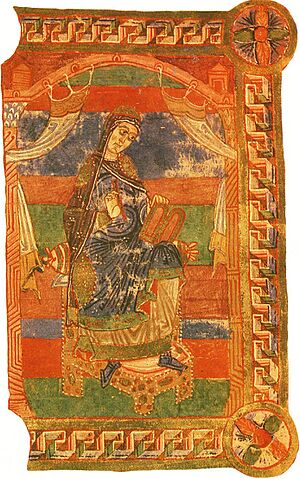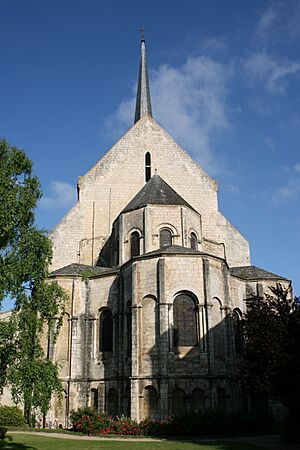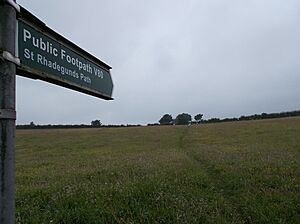Radegund facts for kids
Quick facts for kids Saint Radegund |
|
|---|---|

11th-century depiction of Radegund
|
|
| Born | c. 520 Thuringian tribes |
| Died | 13 August 587 (aged 66–67) Abbey of the Holy Cross, Poitiers, Aquitaine, Kingdom of the Franks |
| Venerated in | Roman Catholic Church Eastern Orthodox Church |
| Major shrine | Church of St. Radegonde, Poitiers, Vienne, France |
| Feast | 13 August |
| Patronage | Jesus College, Cambridge |
Radegund (also spelled Rhadegund, Radegonde, or Radigund) was a princess from Thuringia, a German land. She was born around 520 AD. Later, she became a queen of the Franks, a powerful group of people in what is now France.
Radegund is famous for starting the Abbey of the Holy Cross in Poitiers, France. She is considered a patroness saint for many churches in France and England. She is also a special saint for Jesus College, Cambridge in England.
Contents
Radegund's Early Life
Radegund was born about 520 AD. Her father, Bertachar, was one of the kings of Thuringia. Sadly, her uncle, Hermanfrid, killed her father in a battle. Hermanfrid then took Radegund into his own home.
Hermanfrid made a deal with King Theuderic of the Franks. Together, they defeated Hermanfrid's other brother. After winning, Hermanfrid took control of Thuringia. But he broke his promise to share power with King Theuderic.
Captured by the Franks
In 531, King Theuderic returned to Thuringia with his brother, Clotaire I. They defeated Hermanfrid and took over his kingdom. Clotaire I took Radegund with him back to Gaul, which was the land of the Franks.
Radegund was still a child at this time. Clotaire I sent her to live in a villa for several years. In 540, when she was older, he married her.
Radegund was one of King Clotaire I's many wives. She did not have any children with him. Radegund was known for being very generous and giving to those in need.
A New Path
Around 545, Radegund's brother was the last male member of her royal family. King Clotaire had him killed. This event deeply saddened Radegund.
She decided to leave the royal court and seek protection from the Church. She convinced Medardus, a bishop, to make her a deaconess. A deaconess is a woman who helps the church.
Radegund then founded a monastery called Sainte-Croix in Poitiers around 560 AD. In this monastery, she dedicated her life to helping others. She was especially known for caring for sick people. Many believed she had the gift of healing.
Life in the Monastery
The nuns at Sainte-Croix followed a special set of rules. These rules were from Caesarius of Arles, a religious leader. The nuns had to be able to read and write. They spent many hours each day reading religious texts and copying manuscripts. They also did traditional tasks like weaving.
The rules kept the nuns very enclosed. This meant they could not leave the monastery easily. Because of these strict rules, the nuns at Sainte-Croix could not even attend Radegund's funeral.
The Holy Cross Relic
Radegund's abbey was named after a special relic. A relic is a sacred object. This relic was a piece of the True Cross, which is believed to be the cross Jesus was crucified on. Radegund received this relic from the Byzantine Emperor Justin II.
A local bishop at first refused to place the relic in her abbey. So, Radegund asked King Sigebert I for help. The king sent another bishop, Eufronius of Tours, to Poitiers. He performed the ceremony to install the relic in the abbey.
To celebrate this important event, a poet named Venantius Fortunatus wrote several hymns. One of these hymns is the famous Vexilla Regis. This hymn is still sung today in Christian services, especially on Good Friday.
Radegund was a close friend of Junian of Maire. It is said that both Radegund and Junian died on the same day, August 13, 587.
Radegund's Simple Lifestyle
Radegund was known for her very simple and strict way of living. She chose to eat only plant-based foods. She ate only legumes and green vegetables. She did not eat fruit, fish, or eggs.
She also did not drink wine, mead, or beer. During Lent, a religious fasting period, she ate even less. She would only drink a little water. Radegund followed this strict lifestyle even when others told her it might make her sick.
Friends and Writings
The poet Venantius Fortunatus and the historian Gregory of Tours were close friends with Radegund. They wrote a lot about her life. Radegund herself wrote Latin poems to Fortunatus on tablets, but these writings are now lost.
Historians believe that Radegund wrote two poems herself: De Excidio Thoringiae and Ad Artachin. These poems tell stories from her life.
Another nun named Baudovinia also wrote a biography about Radegund. This was after a difficult time at the abbey.
Radegund's funeral took place three days after her death. Both Venantius Fortunatus and Gregory of Tours attended. She was buried in what is now the Church of St. Radegonde (Poitiers) in Poitiers. Her tomb is still there in the church's crypt. People still visit it to honor her.
In the 1260s, the church was decorated with stained-glass windows. These windows showed scenes from Radegund's life. Sadly, many of these windows were later destroyed.
What Radegund Represents
Radegund is often shown in pictures wearing royal robes, a crown, and holding a scepter. Sometimes, there are wolves or wild animals near her, but they are calm in her presence. She might also be shown with a shepherd's staff and a book. Other images show her with a white headdress and a tunic decorated with flowers or castles.
Places Named After Her
Many places are named after Saint Radegund.
- In England, five parish churches are dedicated to her.
- She also had chapels in important cathedrals like Old St Paul's Cathedral, Gloucester Cathedral, Lichfield Cathedral, and Exeter Cathedral.
- St. Radegund's Abbey, near Dover, was founded in her honor in 1191.
- Longleat Priory in Wiltshire was also dedicated to her.
- Jesus College, Cambridge is a college at Cambridge University. It was built on the site of an old priory (a type of monastery) that was dedicated to Saint Radegund.
- A public house (a type of pub) in Cambridge is called "The St Radegund."
- A holiday and conference center on the Isle of Wight is also named after her.
Many places in France are named Sainte-Radegonde.
In Austria, two places are named after Saint Radegund:
- Sankt Radegund in Upper Austria is a municipality near the border with Germany.
- Sankt Radegund bei Graz is another municipality in the Austrian state of Styria.
In Germany, near the ruins of Mühlburg castle, you can find the foundations of a chapel dedicated to St Radegund. This chapel is above the village of Mühlberg in Thuringia.





